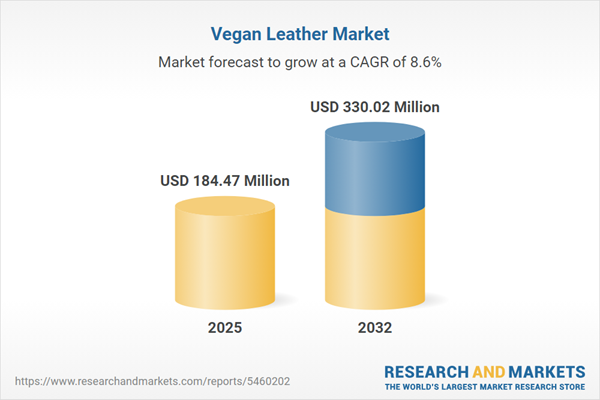Speak directly to the analyst to clarify any post sales queries you may have.
The vegan leather market is rapidly evolving as brands and supply chains recognize the importance of sustainable alternatives, innovative materials, and responsible sourcing to meet changing consumer and regulatory expectations.
Market Snapshot: Vegan Leather Market Size and Growth
The vegan leather market grew from USD 170.82 million in 2024 to USD 184.47 million in 2025. Continuing its robust trajectory, the sector is projected to expand at a CAGR of 8.57%, reaching USD 330.02 million by 2032. This growth illustrates the steady migration of sustainable materials from niche experimentation to broad adoption across consumer goods and industrial domains.
Scope & Segmentation of the Vegan Leather Market
- Type: The market includes plant-based options such as apple, coconut, cork, mushroom (mycelium), and pineapple (Piñatex) leathers, as well as synthetic alternatives like bio-based synthetic leathers, polyurethane (PU), and polyvinyl chloride (PVC).
- Texture: Market segmented into glossy, matte, and textured finishes, addressing varied requirements across luxury and everyday applications.
- Production Method: Covers bio-based, petrochemical-based, and recycled routes, reflecting diverse approaches to sustainability and scalability.
- Application: Principal use cases include automotive interiors, electronics and gadgets, fashion and apparel, footwear, and furniture and upholstery, supporting wide-ranging industry integration.
- Supply Chain Model: Examines direct-to-consumer (D2C), retail distribution, and wholesale/B2B strategies, capturing distinctive value chain configurations.
- Region: Analysis extends across Americas (including detailed North America and Latin America), Europe, Middle East & Africa, and Asia-Pacific, mapping out nuanced regional drivers and adoption patterns.
- Company Coverage: Key participants assessed include Allbirds, Inc., Alternative Leathers Co., Ananas Anam Ltd., ATMA LEATHER PRIVATE LIMITED (Banofi), Beyond Leather Materials ApS., Bolt Threads, Inc., BZ Leather Company, CUT & STITCH LIMITED, Dongguan Boze Leather Co., Ltd., and Dongguan Huichung Cork Products Co., Ltd.
Key Takeaways for Senior Decision-Makers
- Material innovation, such as mycelium cultivation and advanced plant-fiber processing, is at the forefront of reducing lifecycle impact and supporting product differentiation.
- Cross-sector demand, especially from fashion, automotive, and electronics, is driving rapid advances in both capacity and sophistication of vegan leather supply chains.
- Adoption of circular supply chain practices and rigorous supplier qualification enhances resilience, compliance, and sustainable value generation.
- Strategic partnerships between material innovators and leading brands accelerate product development cycles and broaden market reach.
- Technological advances, including modular manufacturing and 3D-printable laminates, are unlocking new business models and reducing production waste, further supporting sustainability goals.
- Strong regulatory and consumer pressures around environmental standards, ethical sourcing, and decarbonization are influential in directing R&D and procurement strategies.
Tariff Impact: How US Policy Is Shaping Raw Material Strategies
The introduction of new US tariffs in 2025 on select bio-based polymers and plant derivatives has triggered cost adjustments across the vegan leather supply chain. These measures are prompting manufacturers to diversify sourcing by investing in domestic capabilities, pursuing new regional suppliers, and considering vertical integration where feasible. For industry leaders, balancing supply chain agility with cost and compliance resilience remains essential as global trade policies evolve.
Methodology & Data Sources
This report’s findings are grounded in primary interviews with executives from material science, supply chain, and product design functions, complemented by extensive secondary research, including industry journals, patents, and regulatory filings. Data triangulation and iterative expert validation were used to substantiate trends and ensure analytic rigor.
Why This Report Matters
- Offers clear guidance to executives aiming to strengthen sustainable sourcing, supply chain resilience, and product innovation in the vegan leather space.
- Equips leaders with detailed segment, region, and company insights to inform investment and partnership strategy.
- Enables decision-makers to assess competitive positions, anticipate supply risks, and leverage technology-driven differentiation for sustainable growth.
Conclusion
The vegan leather market is advancing through coordinated innovation, sustainability-driven adoption, and adaptive supply chains. Organizations equipped with insights from this report are well-positioned to address emerging opportunities and challenges across dynamic global markets.
Additional Product Information:
- Purchase of this report includes 1 year online access with quarterly updates.
- This report can be updated on request. Please contact our Customer Experience team using the Ask a Question widget on our website.
Table of Contents
3. Executive Summary
4. Market Overview
7. Cumulative Impact of Artificial Intelligence 2025
Table Information
| Report Attribute | Details |
|---|---|
| No. of Pages | 197 |
| Published | November 2025 |
| Forecast Period | 2025 - 2032 |
| Estimated Market Value ( USD | $ 184.47 Million |
| Forecasted Market Value ( USD | $ 330.02 Million |
| Compound Annual Growth Rate | 8.5% |
| Regions Covered | Global |
| No. of Companies Mentioned | 11 |









